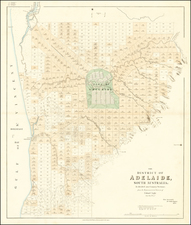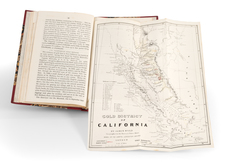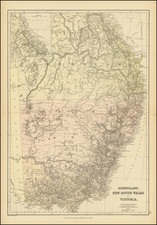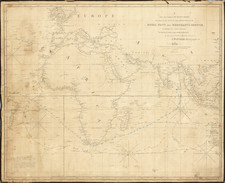Early Map of Sydney, Australia.
Fantastic map of the region around Sydney, Australia, showing Port Hacking, Botany Bay, Port Jackson, and Broken Bay. This map was produced following the Freycinet report on an expedition led by Nicolas that attempted to place a French claim on western Australia.
The primary map shows the Sydney region in fantastic detail. Parramatta, Hawkesbury, Tongabee, Castle Hill, Brick-Field and Sydney are the only settlements named. Early maritime and land roads are shown. The map was published less than half a century after the first-ever map of Botany Bay and the Sydney area, produced as part of the Cook expedition.
The Baudin expedition was part of the Napoleonic-era French desire to have an increased role in the mapping of the lesser-known parts of the world, particularly in the Pacific and Indian Oceans. During this period, a number of important and rare early surveys of California, Australia, and the western coast of Latin America were produced.
The other two maps included show the Investigator Group of islands that lie in the Great Australian Bight. Located off the Eyre Peninsula. The lower chart renames South Australia "Napoleonland," and shows Wedge Island near Adelaide.
Louis Freycinet and the Baudin Expedition
The map that this is based on featured in the rarest of the volumes to come out of the Baudin expedition. When Nicolas Baudin left Le Havre in the Geographe and the Naturaliste in October 1800, he was embarking on a voyage meant to survey the shores of Australia. At this time, the British had established their presence in eastern Australia, but the western and southern portions of the continent remained unexplored and not necessarily claimed by the British. In other words, although ostensibly a scientific expedition, the French were also open to possible overseas expansion if the opportunity arose.
In the Naturaliste, commanded by Captain Jacques Hamelin, was Louis Freycinet, then only 21 years old. He had joined the French Navy in 1793 and was accompanied on this voyage by his brother, Louis-Henri, who would go on to become an admiral. Henri Freycinet also has his own geographical feature on this chart, the Havre Henri Freycinet.
Initially the ships, sometimes separated, made their way north up the western coast of Australia from Cape Leeuwin to Timor. Eventually, Baudin and the Geographe made for Van Diemen's Land and then returned toward the west. En route, they encountered British naval officer Matthew Flinders in the Investigator. Flinders, on his third Australian surveying mission, was heading to Sydney, from where he would begin a clockwise circumnavigation of the Australian continent, the first such voyage to ever do so. Flinders named the place where he and Baudin met Encounter Bay.
Baudin and Hamelin were reunited in Sydney, where both ships had come to recuperate in late 1801. While there, Baudin purchased a 29-foot vessel. He named it Casuarina and placed Freycinet, who had proved himself an adroit hydrographer under Hamelin, in command. With his new charge, Freycinet was to perform inshore surveys.
During the course of 1802, the Geographe and the Casuarina surveyed the southern coast of Australia (the Naturaliste had been sent back to France). They then sailed round the west coast to Timor, then back to Mauritius, where Baudin died. It was also where the Casuarina's career ended, as the ship was abandoned in favor of consolidating the crews on the Geographe. The ship returned home on March 25, 1804.
Louis Claude Desaulses de Freycinet (1779-1841) was a French hydrographer and explorer. He joined the French Navy in 1793. In October 1800, at the age of 21, Freycinet set off in the Naturaliste, part of an exploratory expedition to chart Australia. He was accompanied on this voyage by his brother, Louis-Henri, who would go on to become an admiral.
In Sydney, the leader of the expedition, Nicholas Baudin, purchased a 29-foot vessel. He named it Casuarina and placed Freycinet, who had proven himself an adroit hydrographer, in command. With his new charge, Freycinet was to perform inshore surveys. During the course of 1802, the Casuarina charted large portion of the southern coast of Australia.
Freycinet returned to France in 1804. Since Baudin had died in Mauritius, the naturalist Francois Peron and Freycinet were directed to prepare for publication the official account of the voyage, with an accompanying atlas. The official account appeared over ten years and in four volumes. The first narrative of the voyage, primarily by Peron, was published in 1807. The second narrative volume was published in 1816 and was written primarily by Freycinet. Peron had died in 1810. The first part of the Atlas, which contained 40 engraved plates, two of them folding, appeared in 1807. The second atlas, was published in 1811 with 14 engraved charts, two of them double-page. These double-page maps include a map of the Australian continent, the first map to show the continent in its entirety and made partially from Matthew Flinders’ papers.
His publications stemming from the Baudin expedition would have been enough to secure the fame of Louis Freycinet. However, he is perhaps best known today for his second voyage to the Pacific, one he commanded in the Uranie. From 1817 to 1820, Freycinet cruised the Pacific performing experiments and, of course, making detailed charts. He was accompanied by his wife Rose.
Although the Uranie was wrecked in the Falklands on the return journey, the natural historical specimens and geographical notes were saved. They were published in 13 volumes with 4 additional volumes of plates and maps between 1824 and 1844.
The voyage secured Freycinet a place in the Academie des Sciences. He also went on to help found the Paris Geographical Society, the first such group of its kind. Louis Freycinet died in 1841.










![Benedict Arias Montanus Sacrae Geographiae Tabulam ex Antiquissimorum Cultor. [Pre-Dutch Discovery Depiction of Australia]](https://storage.googleapis.com/raremaps/img/small/89169.jpg)



![Neu-Seeland [with] West Australien [with] Tasmania](https://storage.googleapis.com/raremaps/img/small/98073.jpg)